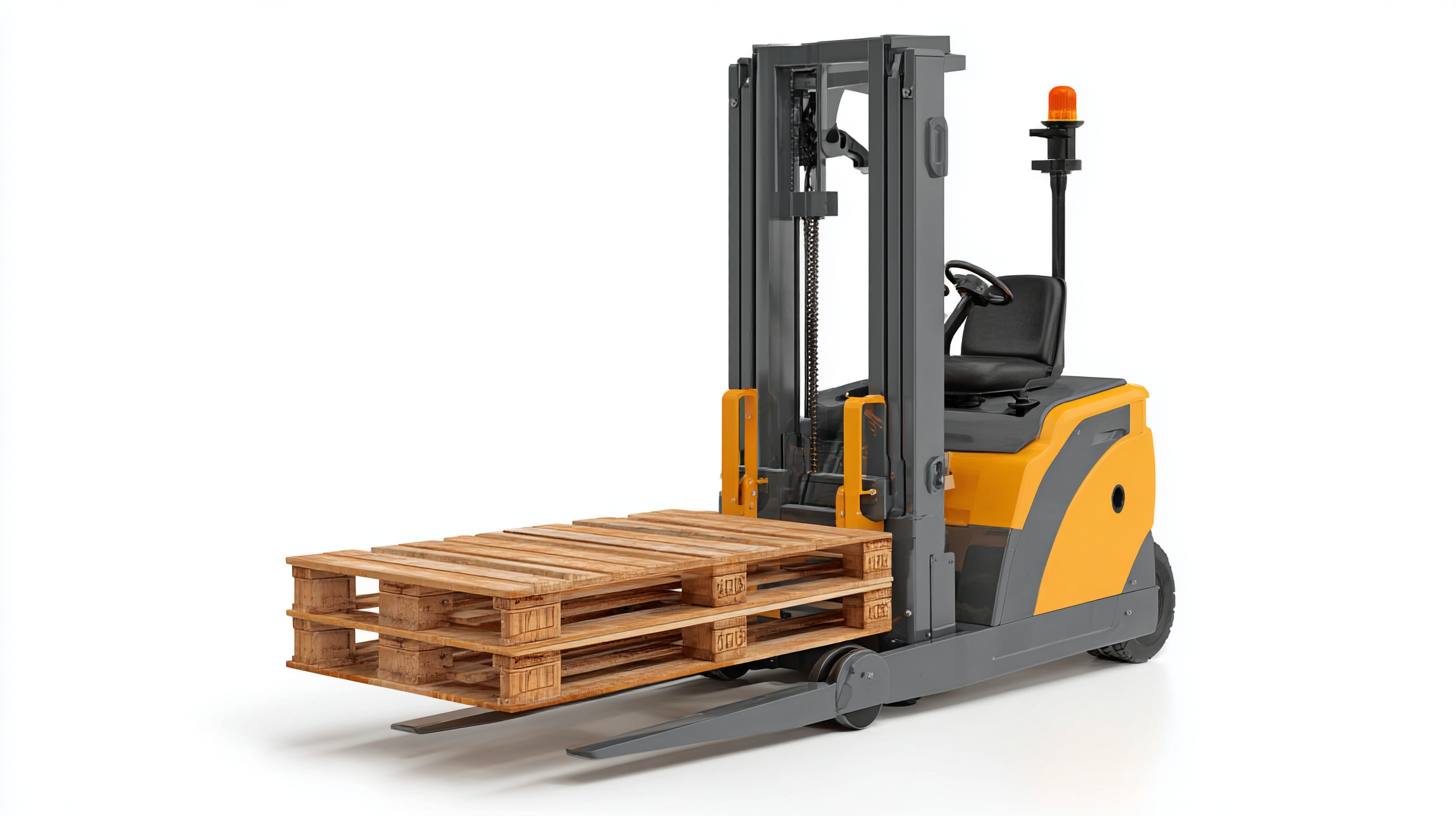Leave Your Message
In the ever-evolving landscape of material handling, the Long Fork Pallet Jack has emerged as a critical tool for enhancing efficiency and productivity in warehouses and distribution centers. According to a report by the Material Handling Industry of America (MHIA), the use of specialized pallet jacks can lead to a 20-30% reduction in time spent on item retrieval and transportation. This is particularly significant in operations that require the movement of oversized loads, where conventional pallet jacks often fall short.
 The Long Fork Pallet Jack, with its extended forks capable of accommodating larger pallets, offers a unique advantage by facilitating smoother and safer handling of bulkier items. As businesses continue to prioritize operational efficiency and safety, understanding the unique benefits and ideal applications of the Long Fork Pallet Jack becomes paramount for industry leaders seeking to optimize their supply chain processes.
The Long Fork Pallet Jack, with its extended forks capable of accommodating larger pallets, offers a unique advantage by facilitating smoother and safer handling of bulkier items. As businesses continue to prioritize operational efficiency and safety, understanding the unique benefits and ideal applications of the Long Fork Pallet Jack becomes paramount for industry leaders seeking to optimize their supply chain processes.
When selecting a long fork pallet jack, understanding its key features is essential for optimal performance in material handling operations. One of the most significant attributes of long fork pallet jacks is their extended fork length, which allows for the efficient handling of oversized pallets and larger loads. This feature is particularly advantageous in warehouses and distribution centers, where space optimization is crucial. The ability to accommodate larger pallets not only enhances productivity but also reduces the number of trips required to move goods, ultimately leading to time and cost savings.
Another critical aspect is the robust construction and design of long fork pallet jacks. Many models come equipped with reinforced forks, designed to withstand heavy-duty use without compromising on maneuverability. Additionally, ergonomic handles and intuitive controls are vital for ensuring operator comfort and minimizing fatigue during prolonged use. Innovative features like twin wheel configurations improve stability and weight distribution, allowing for smoother navigation in tight spaces. By focusing on these key characteristics, businesses can ensure that they choose a long fork pallet jack that meets their operational needs and enhances overall efficiency.
Long fork pallet jacks are specialized equipment designed for handling goods in various industrial sectors, offering unique advantages that enhance efficiency and safety. In industries such as warehousing and logistics, where space can be limited, these jacks provide an essential solution. For example, a 2022 report from the Material Handling Industry of America indicated that companies utilizing long fork pallet jacks have reported a 20% increase in productivity when moving long or oversized loads, such as furniture and construction materials. This is particularly advantageous in settings like home improvement stores and lumber yards, where traditional pallet jacks may struggle with lengthier items.

Food and beverage sectors also benefit from long fork pallet jacks due to their ability to accommodate heavy and bulky items. According to a case study by the International Food and Beverage Association, facilities using long fork jacks reduced the risk of product damage and handling injuries by 30%, contributing to safer work environments and lowering operational costs. These applications highlight the versatility of long fork pallet jacks, proving invaluable across diverse sectors where efficiency, safety, and space optimization are paramount.
When comparing long fork pallet jacks to standard models, it's essential to consider their unique advantages and limitations.
 Long fork pallet jacks are specifically designed to handle longer loads, which makes them ideal for industries dealing with oversized pallets or lengthy materials. This feature not only enhances stability during transport but also minimizes the risk of product damage. Moreover, their extended forks allow for better maneuverability in tight spaces, making them highly efficient in warehouses and manufacturing settings.
Long fork pallet jacks are specifically designed to handle longer loads, which makes them ideal for industries dealing with oversized pallets or lengthy materials. This feature not only enhances stability during transport but also minimizes the risk of product damage. Moreover, their extended forks allow for better maneuverability in tight spaces, making them highly efficient in warehouses and manufacturing settings.
On the other hand, standard pallet jacks are more versatile when handling regular-sized pallets. They typically require less space for maneuvering and are generally easier to operate for basic tasks. However, the growing emphasis on electric pallet jacks in the industry is noteworthy. As of 2023, the electric pallet truck adoption rate in China is about 64%, driven by improvements in efficiency and reduced operational costs. This shift suggests that while long fork pallet jacks offer distinct benefits, the landscape of material handling equipment is evolving rapidly, with electric models gaining traction for their cost-effectiveness and sustainability. The choice between long fork and standard pallet jacks may ultimately depend on specific operational needs and the types of loads frequently handled.
Maintaining a long fork pallet jack is essential for ensuring its longevity and optimal performance. Regular inspections can help identify potential issues before they escalate. Check the wheels and forks for wear and tear, as these components are crucial for smooth operation. Keeping the pallet jack clean will also prevent dirt and debris from affecting its functionality and can prolong its life significantly.
In the evolving landscape of material handling equipment, where technology is advancing rapidly, ensuring that your long fork pallet jack is well-maintained is more important than ever. This equipment is becoming sophisticated, adapting to modern design and application needs. By following recommended maintenance practices, such as lubricating moving parts and checking battery conditions if applicable, you can take full advantage of the enhanced capabilities of these machines. Investing time in proper care not only extends the lifespan of the pallet jack but also contributes to safer and more efficient operations in any warehouse or distribution environment.
Operating a long fork pallet jack can significantly enhance efficiency, particularly in warehouses or large retail spaces. To maximize your productivity, ensure you maintain a clear line of sight while maneuvering the jack. This will help you avoid obstacles and ensure safe handling of materials. Additionally, using the jack on a stable, flat surface can prevent tipping and promote better control during operation.
Tip 1: Always adjust your speed according to the load and environment. Moving too quickly can lead to accidents, while excessive slowness can waste valuable time. Finding a balanced speed enhances both safety and efficiency.
Tip 2: Before starting, familiarize yourself with the weight capacity of your pallet jack. Overloading can not only damage the jack but also create safety hazards. Always check the total weight of the load to ensure it’s within the recommended limits.
Lastly, regularly practice proper lifting techniques. This involves bending your knees and keeping the load close to your body, which not only aids in efficient lifting but also minimizes the risk of injury. Proper training and attention to detail while operating a long fork pallet jack can make a substantial difference in daily operations.
| Feature | Description | Ideal Application |
|---|---|---|
| Extended Fork Length | Allows for handling larger pallets and wider loads. | Ideal for warehouse environments with oversized pallets. |
| High Weight Capacity | Designed to handle heavier loads compared to standard pallet jacks. | Suitable for transporting heavy materials in manufacturing sectors. |
| Ergonomic Design | Engineered for easier maneuverability and reduced strain on operators. | Useful in busy loading docks and tight spaces. |
| Durable Construction | Made from high-quality materials for long-lasting use. | Designed for heavy-duty usage in industrial settings. |
| Adjustable Features | Some models offer adjustable forks for varied pallet sizes. | Flexibility in warehouses with different pallet types. |
